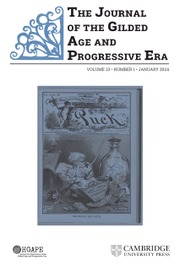So much of the Gilded Age and Progressive Era stemmed from the Civil War. A number of significant Gilded Age fortunes were built during and after the sectional conflict, while many Progressive Era reformers were born and raised in the years surrounding secession and war. The railroads that helped spawn the war and facilitated its execution also built the economies of scale that fueled development of an urban-industrial society. Meanwhile, the rise of large-scale transportation and communications infrastructures allowed Americans to create a public sphere in which they continued to debate the meanings of their imperfectly reconstructed society.
This issue of The Journal of the Gilded Age and Progressive Era illustrates, among other things, the enduring legacy of the Civil War. In “Mr. Bentley Goes to Washington: Reform, Reaction, and Competing Conceptions of Government in the Civil War Pension System, 1876–1881,” Robin Bates examines the career of John Bentley, who was appointed by President Ulysses S. Grant to be Commissioner of Pensions in 1876. As Bates shows, Bentley introduced a plan that would have made the nation’s increasingly vast and complex pension system more efficient, but he faced pushback and, eventually, termination. Bentley was a bureaucrat who would have enlarged the scope and strength of the welfare state, but his vision was thwarted by the realities of Gilded Age political culture. In the second article, Patrick Grigsby shows how New Yorkers navigated the fluctuating power of the Tammany Hall machine during the half-century after 1870. In “Evaluating Plunkitt’s ‘Solemn Contract’: Working-Class Perspectives on Tammany Hall and Upper-Class Reform Politics, 1870–1924,” we see how voters periodically embraced reform candidates for New York City mayor—but then frequently returned to Tammany candidates when the reformers failed to deliver on their promises. While it sometimes worked to run against corruption, whether real or perceived, negative partisanship was rarely adequate for most voters in the nation’s largest metropolis.
In “The Death of Ulysses S. Grant and the Politics of Reconstruction Memory in the 1880s,” Belle Grenville-Mathers examines national discourses surrounding the death of the United States’ eighteenth president. For many Americans, Grant was a beloved Union general and political leader, yet others in the war-torn nation despised him. Indeed, this article shows us that the Civil War and Reconstruction were still widely contested in cultural memory during the days, weeks, and months following Grant’s death on July 23, 1885. Even in his political afterlife, the wartime commander-in-chief remained significant. This issue’s final article takes us to the era of World War I, the other conflict bookending the Gilded Age and Progressive Era. In “‘A Crime Against Humanity’: Prison, Capitalism, and Convict No. 9653 (Eugene V. Debs),” John Popiel illustrates how Eugene Debs, a veteran labor leader and socialist presidential candidate, wrote movingly about his imprisonment in federal penitentiaries after his arrest and conviction for violating the 1917 Espionage Act (by delivering an antiwar speech in Ohio in 1918). Debs learned much from his time in prison—an institution that he hated, and saw as intertwined with capitalism—and subsequently offered suggestions for the reform or abolition thereof.
We close this issue with a half-score of reviews of books on subjects as diverse as Black women’s fitness, urban vice in San Francisco, auto racing in Indianapolis, new immigrants in New South Alabama, Irish Catholic dissidents, and blinded World War I veterans, among other topics. Gilded Age and Progressive Era history, to be sure, is a house with many rooms.
Although I remain firmly convinced that common people are the primary agents of historical change, the pieces of cutting-edge scholarship featured in this issue—combined with the occasionally overwhelming realities of our own times—demonstrate that the actions of political leaders (and even obscure functionaries) can matter a great deal, as do the conflicts our society enters and endures. Certainly, this issue of the journal will continue to focus our attention on the persistent relevance of late nineteenth- and early twentieth-century U.S. history.


